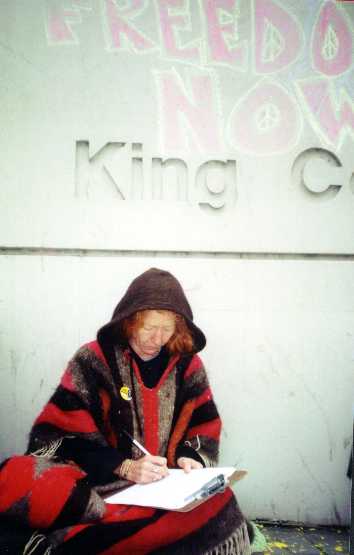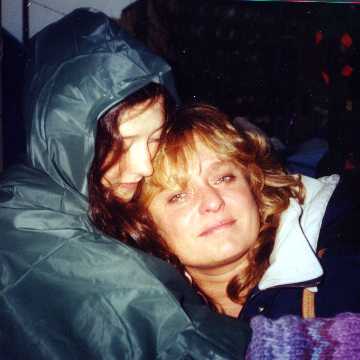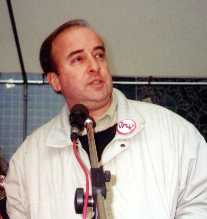|
Back to On the Road with John Tarleton
Back to Love and Rage in Seattle: The Day the WTO Stood
Still
WTO Photos: Faces of Resistance

Ruhama Pemberton of Mount Vernon, Washington fills out a complaint form
against the Seattle Police Department. A self-described "country-hippie
girl" who works as an herbalist at the Skagit Valley Food Co-op, she came
to Seattle for the WTO protests. She was sitting in a tavern having a beer
with a friend when the police stormed through the Capitol Hill
neighborhood on the night of November 30. Tear gas soon permeated the
tavern and the bartender tossed rags to people as they began crying and
choking.
Five days later, Pemberton was still suffering headaches and blurry
vision. Her lungs still felt heavy and she was prone to flinching all the
time. And, she said, hardly an hour passed without her crying. She was
using milk thistle to detoxify her liver.
"The city used chemical warfare against peaceful demonstrators," she said.
"There's no other way to describe it."
Still, she had no regrets about coming to Seattle.
"I'm glad I put my body on the line," she said. "If I had to do it all
over again, I would. 90% of my crying is for sheer joy at the beauty of
all this, at what we've accomplished and to see so many people dancing and
drumming."
 Sandy Cilk of Whidbey Island, Washington waits outside the King County
Jail for her daughter, Lotus, to be released.
Sandy Cilk of Whidbey Island, Washington waits outside the King County
Jail for her daughter, Lotus, to be released.
 Brian Derdowski, an outgoing member of the King County Commission, calls
for an investigation into widespread reports of police brutality against
anti-WTO protesters. Hundreds of complaints were filed by the end of the
vigil, and both the Washington State chapter of the ACLU and the National
Lawyers Guild were looking into filing class action lawsuits against the
City of Seattle and King County.
Brian Derdowski, an outgoing member of the King County Commission, calls
for an investigation into widespread reports of police brutality against
anti-WTO protesters. Hundreds of complaints were filed by the end of the
vigil, and both the Washington State chapter of the ACLU and the National
Lawyers Guild were looking into filing class action lawsuits against the
City of Seattle and King County.
| 
 Sandy Cilk of Whidbey Island, Washington waits outside the King County
Jail for her daughter, Lotus, to be released.
Sandy Cilk of Whidbey Island, Washington waits outside the King County
Jail for her daughter, Lotus, to be released.
 Brian Derdowski, an outgoing member of the King County Commission, calls
for an investigation into widespread reports of police brutality against
anti-WTO protesters. Hundreds of complaints were filed by the end of the
vigil, and both the Washington State chapter of the ACLU and the National
Lawyers Guild were looking into filing class action lawsuits against the
City of Seattle and King County.
Brian Derdowski, an outgoing member of the King County Commission, calls
for an investigation into widespread reports of police brutality against
anti-WTO protesters. Hundreds of complaints were filed by the end of the
vigil, and both the Washington State chapter of the ACLU and the National
Lawyers Guild were looking into filing class action lawsuits against the
City of Seattle and King County.